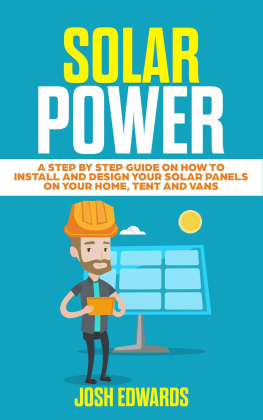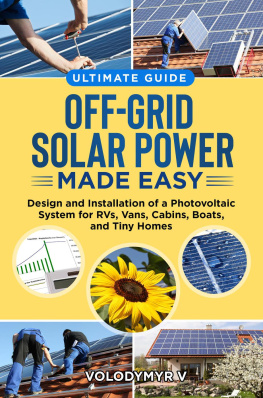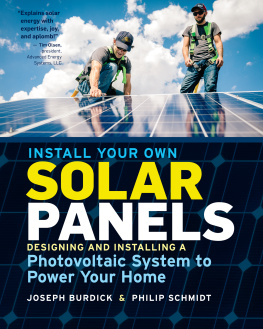
Cover design by Nick Caruso Design
Cover photograph Elena Elisseeva / Shutterstock.com
Photo Credits
Page : tomprout/iStockphoto.com;
Photographs on pages courtesy of National Renewable Energy Laboratory. 2016 by National Renewable Energy Laboratory.
All other photographs courtesy of the author.
Copyright 2016 by Mike Sullivan
All rights reserved
For information about permission to reproduce selections from this book, write to Permissions, The Countryman Press, 500 Fifth Avenue, New York, NY 10110
For information about special discounts for bulk purchases, please contact W. W. Norton Special Sales at specialsales@wwnorton.com or 800-233-4830
THE COUNTRYMAN PRESS
www.countrymanpress.com
A division of W. W. Norton & Company
500 Fifth Avenue, New York, NY 10110
www.wwnorton.com
978-1-58157-398-5 (pbk.)
978-1-58157-533-0 (e-book)
DEDICATION
To my loving children and four beautiful grandchildren.

CONTENTS


This book is written for the benefit of homeowners all over the world, especially those who care about the environment and those who want to save money by permanently reducing their monthly electric bill . The book provides a useful step-by-step guide full of photos to help DIY enthusiasts and others understand the basics of installing a solar photovoltaic (PV) rooftop system.
The book is written in everyday language that is easy for readers to understand and doesnt bog them down in technical terms and diagrams or engineering concepts. Solar energy is a high-tech business, but this book simplifies and demystifies the technology for everyone interested in this amazing source of free energy.
Millions of homeowners around the world are already enjoying the benefits of clean solar energy and saving a lot of money in the process. Youll learn why and how within the chapters of this guide book. The book will explain the various options as well as the main features, components, advantages, and disadvantages of the different basic technologies available, and it will provide detailed installation planning tips. Ill answer all your questions and help you select the best system for your needs and your budget. Ill also show you how much you can expect to spend for any size and type of installation and how to calculate the substantial savings you can expect over the short and long term.
Go solar, go green, save money, and help the environment. Its a timely and unstoppable global trend.


Most municipalities permit homeowners or do-it-yourself enthusiasts to install a PV rooftop solar system; often a simple inspection and approval by a qualified electrician or certified solar installer will be all you need.
Theyre fast to install. Usually an installation can be completed in a weekeven by a DIYerafter all the required equipment and materials are on site. Energy independence is an advantage that has strong appeal for many homeowners, and PV solar systems can reduce vulnerability to power loss from grid blackouts or power outages. You should see immediate savings on your electric bills and begin recovering your investment right away.
PV solar systems are also flexible; you can start small and add more PV panels later on. With solar rooftop systems, everything is modular.
Leasing is available in most areas. If you have limited cash flow, this option can provide an easy way to get a PV solar system installed on your rooftop. Its also easy to obtain financing, if required; most US banks have ample experience financing solar PV rooftop systems. In addition, government cash rebates, tax exemptions, and other financial incentives are often available, and these can substantially reduce the cash investment you need to make. PV systems have a relatively short payback period that can be as short as six or seven yearsor even less, with rebates and other government incentives.
Your solar panel system should have a long and useful life. A warranty of 25 years from module manufacturers is standard. Systems can be installed on both flat and sloped roofs, and even on vertical surfaces. They provide myriad long-term environmental benefits and require almost zero maintenance.
Lastly, they immediately increase the value of your home, often by more than the cost of the PV solar system itself.
This is a formidable list of advantages to installing a PV solar system in your home. The only negative factor is the substantial investment or capital cost of the PV system, but this is generally more than offset by the advantages, financial and otherwise. The guidelines in this book will make it easy for you to calculate the financial and economic aspects of whichever PV solar system you choose for your home. Ill also help you perform a simple cost-benefit analysis of your project or proposed PV system. Reading this book will put you in control.
THE THREE BASIC TYPES OF TECHNOLOGY FOR PV SOLAR PANELS OR MODULES:
Monocrystalline silicon panels
Polycrystalline silicon panels
Thin-film technology (in panels or other formats)
The best-known and most common of these is the polycrystalline silicon panel, and the third type, thin film, has up to four different versions, meaning that there are actually up to six kinds of PV technology to choose from. This might seem confusing at first, but this book will make it easy for you to determine which PV technology type is best for your particular needs.
Here are a few more photographs that illustrate the versatility of solar panel applications and installations.
This book will help you understand the various PV solar technologies and enable you to choose the most advantageous system for your home and budget. It will also give you valuable tips on how to choose a contractor, if this is the route you decide to take. It will show you how to calculate the electric power you can produce using any given system and how much money your chosen system can save on your monthly electric bills.
In , I will outline the main features, advantages, and disadvantages of each available technology type so that you can choose from the diverse range of options and components.
In , I will discuss and illustrate three different options for connecting or not connecting to the electric utility grid: grid-tied, off-grid, and hybrid.
In , I will illustrate and summarize all the major components of a PV solar rooftop system.
In , I will show you how to determine the optimum size of your proposed PV solar rooftop system.
In will also show you an easy way to calculate how much money your PV solar system can save you compared to your existing monthly utility bills over a 12-month period.
Next page


















